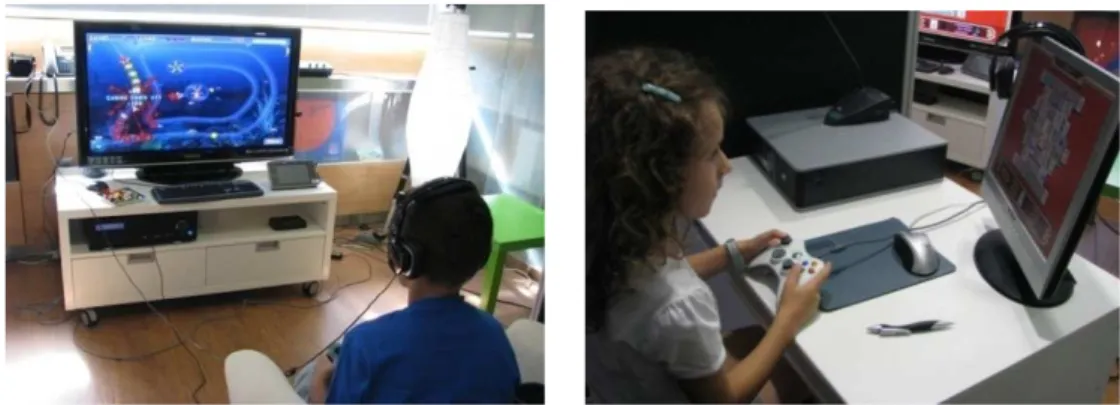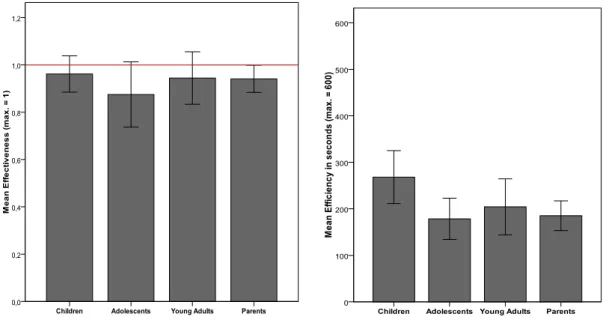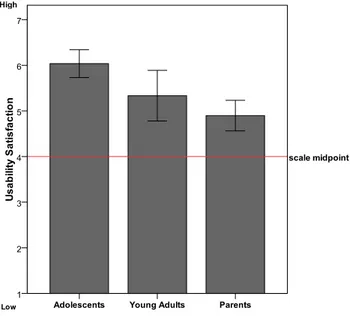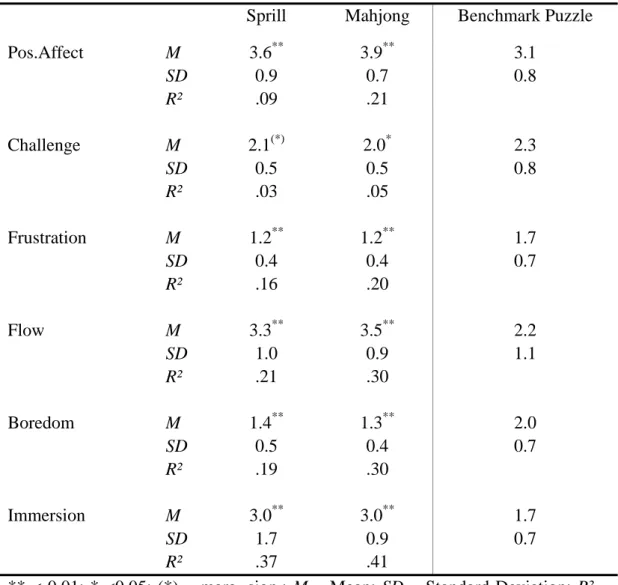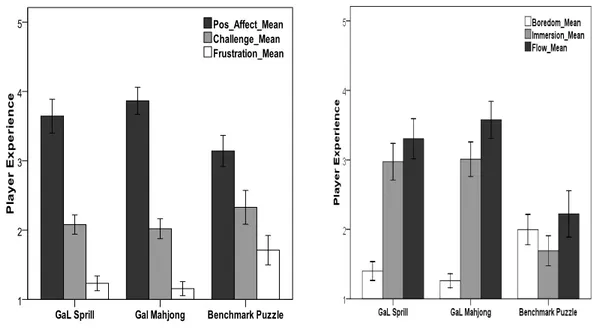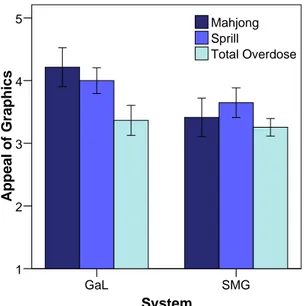183
O Futuro dos Jogos
Distribuídos: Vantagens
Técnicas e Design
Centrado no Utilizador
The Future of Distributed Gaming: Technical Advantages and User-Centred Design
M. Martins1, H. H. Nap2, B. J. Gajadhar3, W. Oosting4, A. Jurgelionis5, R. Carmichael6, L. Silva7, F. Milagaia8, F. Bellotti9, A. De Gloria10, J. Freeman11, H. David12
1,7,8
PT Inovação, Aveiro, Portugal; 2,3,4Eindhoven University of Technology, the Netherlands;
5,9,10
University of Genoa, Italy; 6,11Goldsmiths, University of London, UK; 12Exent Technologies Ltd., Tel Aviv, Israel {1mmartins, 7LuisMiguel-H-Silva, 8fernando-j-milagaia}@ptinovacao.pt; {2H.H.Nap, 3
B.J.Gajadhar, 4W.Oosting}@tue.nl; {5jurge, 9franz, 10adg}@elios.unige.it; {6pss01rc, 11
pss01jf}@gold.ac.uk; 12hdavid@exent.com
1
Maria Martins (BSc), 7Luís Silva (MBm) & 8Fernando Milagaia (MSc) work at PT Inovação. Their research interests include: Applied Research, Knowledge Dissemination, Video Streaming, Interactive TV, Advanced communications services for People with Special Needs, Health Care Services, Telemedicine and eLearning.
2
Henk Herman Nap (PhD), 3Brian Gajadhar (PhD student) & 4Willem Oosting (PhD student) work at the Game Experience Lab of the Human-Technology Interaction group at Eindhoven University of Technology. Their research interests include: Gerontechnology, HTI, Psychonomics, Social & Environmental psychology, and Usability Engineering.
5
Audrius Jurgelionis (PhD student), 9Francesco Bellotti (assistant professor) & 10
Alessandro De Gloria (full professor) work at the University of Genoa. Their research interests include: HCI, Pervasive Computing System design & testing, AI, Virtual Reality, Computer Graphics, and Embedded Systems.
6
12
Haggai David (MSc) works at Extent Technologies, Tel Aviv. Research interests: games distribution & leading the core technologies' group of Exent.
Re su m o
Abst r a ct
Há uma procura potencial por soluções multimédia
interactivas em rede que permitam utilizar jogos de PC
em set-top boxes, PDAs ou noutros dispositivos móveis
de baixo custo. O projecto Games@Large (GaL) tem
desenvolvido uma solução que permitirá a
acessibilidade ubíqua de meios interactivos em
dispositivos com poucas capacidades tecnológicas.
Este artigo descreve a estrutura do GaL e a abordagem
ao ciclo de vida de engenharia de usabilidade que foi
usada para iterativamente desenvolver e avaliar um
protótipo funcional com um interface amigável. O
primeiro estudo empírico mostra que o interface do GaL
está de acordo com os standards de usabilidade para
todos os grupos de utilizadores propostos e os jogos do
GaL proporcionam experiências mais positivas do que
os exemplares actuais. Um segundo estudo empírico é
efectuado para explorar se a experiência dos jogadores
no sistema GaL é acompanhada pelo atractivo dos
gráficos. Os resultados revelaram que a qualidade
gráfica percebida é significativamente superior que o
estado-da-arte de streaming de vídeo. Estudos futuros
permitirão explorar mais as vantagens e as possíveis
limitações do sistema GaL numa escala mais alargada
de jogos e de utilizadores.
There is a potential demand for networked interactive
media solutions that enable the rendering of PC games
on set-top boxes, PDAs or low-cost CE devices. The
Games@Large (GaL) project has been developing such
a solution that would enable pervasive accessibility of
interactive media from low-end devices. This paper
describes the GaL framework and the usability
engineering lifecycle approach that was used to
iteratively develop and evaluate a working prototype
with a user-friendly interface. The first empirical study
shows that the GaL interface meets usability standards
for all proposed user groups and that GaL games are
more positively experienced than current exemplars. A
second empirical study is performed to explore if
players’ experience on the GaL system is accompanied
by the appeal of graphics. Results revealed that the
graphics quality is perceived significantly higher than
state-of-the-art video streaming. Future studies will
further explore the advantages and possible limitations
of the GaL system with a wider range of games and
users.
Palavras-chave: Gaming-on-demand, Streaming,
Design Centrado no Utilizador, Estrutura Games@Large, Experiência do Jogador
Keywords: Gaming-on-demand, Streaming,
185
1 . I n t r odu ct ion
Digital gaming has grown into a booming business. In 2007, computer game sales have
tripled to $9.5 billion since 1996 in the USA (ESA, 2008) and reached 7.3 billion in Europe
(Nielsen Interactive Entertainment, 2008). As early as 1998, Americans spent even more
money on computer games than the amount they spent on cinema tickets (Dill & Dill, 1998).
Nearly all western children play digital games; in the UK for instance, nearly all 6-15
year-olds, and 82% of 16-24 year-year-olds, play digital games (Pratchett, 2005), with similar figures in
the USA (Roberts, Foehr & Ridout, 2005) and Canada (ESAC, 2008). However, digital games
are also popular among other age groups; about a third of US parents play digital games too.
In fact, the average game player in the USA is 35 years old and the percentage of elderly
gamers (50+ years) increased from 9% in 1999 (ESA, 2005) to 26% in 2008 (ESA, 2008).
Gaming could be considered one of the fastest growing means of entertainment for all age
groups and digital gaming technology is changing faster than ever to suit customers’ needs
and to stay ahead of the competition.
One of the latest advancements in gaming technology is games-on-demand (GoD) by means
of cloud computing. Interest in such gaming-on-demand services, which enable users to
stream or download full-featured electronic games to their personal computer (PC) or game
console via the Internet, is strongest among game enthusiasts but has potential mass appeal. A
recent survey (Cai, 2004) indicated that more than 50 percent of online game enthusiast
households are interested in such a service from their broadband carriers. Aligned with such
findings, telecom operators in general, and internet service providers (ISPs) in particular,
already include online gaming over the broadband network as an important service feature of
their video entertainment bundles. But the patterns of entertainment services and video game
consumption are changing. Mobility and digital home entertainment appliances have
generated the desire to play games not only in front of a home PC but everywhere inside the
house and on the move. Several low-cost consumer electronics end-devices are already
available at home: as a result of TV digitalization, set-top boxes (STBs) have entered the
home and, as a new trend, mini-laptops are gaining popularity. Although these devices are
capable of executing software, modern 3D computer games are too heavy for them
(Jurgelionis et al., 2009). Running interactive content-rich multimedia applications such as
video games requires high performance PC hardware or a dedicated gaming console (Nave et
There is a potential demand for networked interactive media solutions that enable the
rendering of PC video games on set-top boxes, PDAs or low-cost consumer electronic devices
without a significant price increase. The Games@Large (GaL) project (www.gamesatlarge.eu)
has been developing such a solution that would enable pervasive accessibility of interactive
media through low-end devices that rely on different platforms (architectures and operating
systems), thus facilitating users to enjoy video games in various environments (e.g., home,
hotel, internet café, elderly home) without the need to use high-end devices, such as consoles
or PCs. A key aspect of this solution is streaming the output of computer games within a local
area network from a central server to an end device. Depending on the capabilities of the end
device, different streaming techniques may be used. The GaL project has investigated two
different approaches to streaming: (i) video streaming of already rendered frames of the game
and (ii) streaming of graphics commands for local rendering on the end device i.e. 3D
graphics streaming (Eisert & Fechteler, 2007).
1 .1 . Ov e r v ie w of cu r r e n t ga m in g- on - de m a n d sy st e m s
User uptake of gaming platforms and choice of console depend not just on hardware
specifications and functionality but also games catalogues and online services. PC games are
effectively tied to the desktop/laptop and console gaming is seen by many as expensive or for
dedicated gamers only. The Nintendo Wii has broadened the console user base but there
remains a massive potential for mainstream gaming on TV given the right technology
solution, content and services offerings and pricing. There are several established or
forthcoming games-on-demand and games streaming solutions incorporating one or more of
the following elements: downloading and execution of the game on local devices; streaming
within a local network; streaming from remote servers. Advances in wireless home
entertainment networks and connectivity – which stream content between devices within the
home – present potential solutions for playing PC games on TV. Airgo Networks’
faster-than-wired True MIMO Media technology and Orb MyCasting are notable but do not allow
streaming of games. StreamMyGame (Tenomichi Limited) streams any DirectX PC game
running on a main PC to a wide range of lower-end devices in the home including PCs,
notebooks, netbooks, UMPCs, other Linux devices and the PlayStation 3 (players use the
Sixaxis Controller as usual). Users can also record their game play or broadcast games for
spectators. StreamMyGame also enables games to be played remotely over broadband (and
wireless, mobile and WiMAX) networks that have sufficient capacity, potentially supporting
187 Streaming video or graphics from remote servers to the PC or to the TV is the most common
approach for games-on-demand. Examples of these services are: Zeebo, a Wireless 3G video
game console based on low-cost hardware and BREW platform solutions which is targeting
the huge developing markets of Brazil, Russia, India and China (BRIC); with the
EXEtenderTM technology (Exent Technologies Ltd.) and AWOMO (Virgin Games), games are
downloaded over broadband and executed locally on a PC – however, the user can start
playing the game after just a small initial download with remaining data being continuously
fetched during game play; InstantAction (GarageGames) uses a small plug-in and an initial
download of the game to allow users to play 3D games in their web browser; Xtremeplay
(NDS) enables high resolution streaming of computer games to set-top boxes; t5 labs’ ‘Instant
Gaming’ solution for set-top boxes via centralized servers hosted by cable TV or IPTV
operators; OTOY/AMD’s Fusion Rendering platform offers film-quality graphics games to
any internet-enabled device – computer, set-top box or even iPhone; G-Cluster also offers
compression of game content and its streaming as MPEG over the IP network to the IP-STB.;
finally, broadband games-on-demand service OnLive will use video streaming and
compression technologies for gaming on PC or Mac without downloads and their
‘micro-console’ device will also allow gaming on TV.
1 .2 . Ga m e s@La r ge Fr a m e w or k
The GaL framework (Tzruya, Shani, Bellotti, and Jurgelionis, 2006) consists of several
components. First, a Windows PC Local Processing Server (LPS) runs games from the Local
Storage Server (LSS) and streams them to clients. It is responsible for launching the game
process after client-side invocation, managing its performance, allocating computing
resources, filing system and I/O activities, and capturing the game graphics commands or
already rendered frame buffer for video encoding, as well as managing execution of multiple
games and streaming audio. The LPS is further responsible for receiving the game controller
commands from the end device and injecting them into the game process.
Second, the graphics streaming protocol is used for streaming 3D commands to end devices
allowing lower performance devices such as interactive TV set-top boxes (STBs) to present
high performance 3D applications such as games without the need to actually execute the
games locally. The 3D streaming and remote rendering system developed for GaL are
achieved through an architecture based on multiple encoding and transmission layers
(Jurgelionis et al., 2009). The first layer is the graphics’ commands interception on the server
any specific graphics Application Program Interface (API). This implies that the 3D streamed
data are not specific to either DirectX or OpenGL but abstract higher-level concepts common
to all 3D graphics (Jurgelionis et al., 2009). The 3D graphic streaming approach cannot be
used for several mobile devices that lack the hardware capability for accelerated rendering
and cannot render the images locally for displaying. For such cases, the Video streaming
scenario is applied, exploiting H.264 (ISO, 2003) for low-delay video encoding.
Third, the network connection to the game client can be either wired or wireless. GaL wireless
platform relies on the IEEE 802.11 standard family (IEEE, 1999). Currently, the mostly used
WLAN technology is IEEE 802.11g that can, in good conditions, provide the bandwidth
needed for four simultaneous game sessions (Jurgelionis et al., 2009). Priority-based QoS can
be supported in IEEE WLANs with the Wi-Fi Multimedia (WMM) extensions (Jurgelionis et
al., 2009), (Wi-Fi Alliance Technical Committee, 2004) specified by the Wi-Fi Alliance.
Additionally, the client module, running on a Windows/Linux PC or notebook or
WinCE/Linux STB or a Linux-based handheld, receives the 3D graphics command stream
and does the local rendering using the available capabilities (OpenGL or DirectX). For the
video streaming approach, H.264 decoding must be supported, instead. The client is also
responsible for capturing the controller (e.g. keyboard or gamepad) commands and
transmitting them to the processing server (Nave et al., 2008).
1 .3 . Te ch n ica l a dv a n t a ge s a n d ch a lle n ge s
The state-of-the-art gaming-on-demand systems offer a variety of possibilities, but are still
unable to support high-level interactive media such as current successful game titles. Such
applications now need costly ad-hoc adaptation and down-sizing. Using them seamlessly on a
variety of devices would dramatically enlarge the market and increase the user options and
experiences (e.g., allowing multi-player gaming in various environments such as homes,
hotels, internet cafés, elderly houses).
The GaL approach enables the pervasive accessibility of interactive media from devices that
feature different platforms (hardware and operating systems), thus facilitating users to enjoy
video games in various distributed environments without the need for using a single device or
operating system (Jurgelionis et al., 2009). Moreover, using a single PC to execute multiple
games and stream them with a high visual quality to concurrently connected clients via a
wireless or wired network supporting Quality of Service (QoS) (Jurgelionis et al., 2009)
189 doing distributed, high-quality PC gaming on network-connected TVs, which is a rapidly
emerging requirement in the game market.
2 . Use r - ce n t r e d de sign a n d e v a lu a t ion
Important goals of the GaL project are creating a platform on which computer games can be
played, providing easy access to games, enabling personalization options and offering
controllability of displayed content, for a wide range of users. Although GaL should be able to
stream to low-end devices, all targets have to be met without negatively influencing the player
experience (by offering state-of-the-art games) and the game’s image quality (by the use of
3D streaming). To accomplish this, it is important to gather an in-depth understanding about
the needs and abilities of all potential users. User centred design methodology (Norman,
1986) stresses to do so at an early stage of engineering processes, when design adaptations are
still relatively easy to make. Nielsen (1993) introduced the ‘usability engineering lifecycle
model’, consisting of iterative cycles of (re)evaluation and (re)designing focussed on users.
The model indicates competitive analysis (benchmarking) as an important method to evaluate
whether a system’s design follows current conventions and meets quality standards that users
expect from contemporary systems. Adopting the usability engineering lifecycle approach, a
first working GaL prototype was developed and subsequently evaluated with actual users.
Furthermore, to comprehensively understand the effects on users; the usability engineering
lifecycle approach was extended by adding player experience to the model.
In the initial stage of the cycle, a considerable number of user-centred studies have been
performed within the GaL project. User needs and characteristics of all proposed user groups
and play environments were gathered (e.g., Gajadhar, de Kort & IJsselsteijn, 2009; Nap, de
Kort & IJsselsteijn, 2009a). Findings were subsequently used during prototyping by means of
personas and contextual scenarios. A low-fidelity paper prototype then allowed for an early
validation of the interaction design by using expert cognitive walkthroughs, followed by a
second evaluative iteration to filter usability flaws that have not yet surfaced. Therefore, six
heuristic categories – consistency, simplicity, feedback, control, error, and cognitive-overload
– were extracted from literature (Coats & Vlaeminke, 1987; Nielsen & Molich, 1990; Nielsen,
2008; Shneiderman, 1998) and used by five usability experts for evaluating the mid-fidelity
prototype. The usability problems found were resolved in a high-fidelity prototype; a second
heuristic evaluation showed a considerable reduction (by 50%) in the usability flaws (see,
In addition to user centred interface prerequisites, network game systems require Quality of
Service standards that should be met (Jehaes et al., 2003). Therefore, standard HCI methods
(e.g. Henderson, 2001) were applied to measure the effects of the GaL system’s network
performance – latency, jitter, packet loss – on users. Additionally, digital gaming is a leisure
activity which is primarily performed to have a good experience in terms of fun, relaxation
and social interaction (Nielsen, 2008; Gajadhar, de Kort, IJsselsteijn & Poels, 2009).
Therefore player experience was included as a possible indicator for effects of network
impairments (in line with Gajadhar, Nap, de Kort, IJsselsteijn & Oosting, in preparation).
Player experience was addressed by applying the Game Experience Questionnaire (GEQ),
which has been developed by Poels, de Kort and IJsselsteijn (2008). Empirical findings (see
Nap & colleagues, 2009b) of the network performance tests were subsequently used to
improve the GaL prototype, in order to meet the state-of-the-art user requirements regarding
system performance on games-on-demand systems.
By means of the usability engineering lifecycle the high-fidelity prototype needed testing with
actual users. Nielsen (1993) describes this phase as Usability Testing, in which end-users
perform realistic tasks on the interface of which the results provide knowledge about the ‘ease
of use’ of the system under study. Therefore, user tests were performed to gather an extensive
insight in the user friendliness of the GaL UI for different potential user groups. Furthermore,
the GEQ was again employed to study users’ experiences. Since Poels et al. (2008) validated
the GEQ on several user groups (N = 380) that played their games in varieties of play
environments on the most popular platforms, their data can be used as a benchmark to
compare the user evaluations of the GaL system with. After all, the GaL project aims at
providing at least a similar player experience as current conventional gaming systems on the
market. Furthermore, GaL’s graphics quality was benchmarked with a state-of-the-art video
streaming system.
Study 1
Method
Participants, Apparatus & Procedure: Seventeen families and two groups of young adults (N
= 68; all Portuguese) were invited for participation in the user experiment, designed by
Eindhoven University of Technology and PTIN, and performed at a usability lab in Aveiro,
Portugal (see Figure 1 for an overview of the setting). Thirteen children (MAge = 8.7; SDAge =
191
(MAge = 21.0, SDAge = 2.3; 2 female), and thirty-four parents (MAge = 38.1, SDAge = 6.5; 16
female) participated. All participants had experience with computers and the Internet; four
parents did not have experience with digital gaming. The participants performed a set of
representative tasks on the GaL UI and furthermore played a number of games (see, Nap et
al., 2009b). The order of the game tasks and UI tasks was counterbalanced. Two games were
used: a fast paced puzzle game Sprill, and a slow paced puzzle game Mahjong. After the
sessions, they were debriefed, received an USB memory stick for their time in the study, and
were thanked for participation. The usability study took about 1 hour and 30 minutes.
Figure 1: Participants (children) playing games on the GaL system
Measures: Usability was operationalized according to the ISO 9241-11 usability norm (ISO
9241-11, 1998) and measured by the number of tasks performed correctly (effectiveness),
total task time (efficiency), and satisfaction by means of the IBM Usability Questionnaire
(IBM-UQ; Lewis, 1995). After each UI task, participants completed a set of self-report
measures in which they rated the perceived usability of the GaL UI. The reliability for each
IBM-UQ scale – SYSUSE, INFOQUAL, and INTERQUAL – represented by Cronbach’s
alpha ranged between .83 and .96 for each task.
Player experience was measured by using seven scales from the core version of the GEQ
(Poels et al., 2008), which can be appropriately administered to adolescents, young adults and
parents. The GEQ was filled in after the game task. Children did not fill in the IBM-UQ and
the GEQ, since in general, questionnaires should rather be avoided in the evaluation of
products with children below the age of 10 (see, Markopoulos et al., 2008). Reliability on
each GEQ scale is given in Table 1 for Sprill, Mahjong, and the data for Benchmark Puzzle
Table 1. Schematic overview of the internal consistency on each scale of the GEQ for
Sprill, Mahjong and Benchmark Puzzle.
Pos.Affec Competen Challeng Frustratio Flo Boredo Immersio
Sprill .95 .94 .47 .91 .91 .57 .88
Mahjong .90 .91 .39 .91 .90 .40 .87
Benchmar .80 .83 .75 .81 .87 .71 .89
Results/Discussion
Usability: Linear Mixed Model Analysis (repeated measures) was performed on task
effectiveness, task efficiency, and self-reports with Age Group and UI-Task as fixed factors
and subjects as random factor; Internet Experience was included as a covariate.
No significant effects of Internet Experience on Task Effectiveness, nor were significant
differences on effectiveness between age groups found (see Figure 2a), hence the UI is highly
accessible for the whole family. Moreover, most participants were able to perform the tasks
correctly within the time limit (MTask1 = .97 (.17)1; MTask2 = .90 (.03)).
Figure 2: a) Overview of the mean effectiveness scores per age group (SE indicated in
graph); b) Overview of the mean efficiency scores per age group (SE indicated in
graph).
1
193
About all participants were able to perform the search tasks far within the time limit of 600
seconds (see Figure 2b). The mean time in seconds for Task 1 was 176.5 (102.9) and for Task
2 it was 229.7 (149.9). No significant effects were found of Internet Experience on the
usability satisfaction components. All age groups were satisfied with the UI, above scale
midpoint (see Figure 3). Interestingly, overall usability satisfaction was significantly higher
rated by adolescents (M = 6.0 (.7)) than by parents (M = 4.9 (1.4)).
Figure 3: Overview of the mean usability satisfaction scores per age group (1 = low
satisfaction; 7 = high satisfaction; SE indicated in graph; scale midpoint = 4)
Player experience: Two separate MANOVAs were performed for the comparisons of Sprill
and Mahjong with the Benchmark Puzzle games. Results revealed that for Sprill and Mahjong
significant differences were measured in positive affect, challenge, frustration, boredom,
Table 2. Schematic overview of the significant differences and effect sizes for the GEQ
scale between Sprill and the Benchmark Puzzle and between Mahjong and the Benchmark
Puzzle.
Sprill Mahjong Benchmark Puzzle
Pos.Affect M 3.6** 3.9** 3.1
SD 0.9 0.7 0.8
R² .09 .21
Challenge M 2.1(*) 2.0* 2.3
SD 0.5 0.5 0.8
R² .03 .05
Frustration M 1.2** 1.2** 1.7
SD 0.4 0.4 0.7
R² .16 .20
Flow M 3.3** 3.5** 2.2
SD 1.0 0.9 1.1
R² .21 .30
Boredom M 1.4** 1.3** 2.0
SD 0.5 0.4 0.7
R² .19 .30
Immersion M 3.0** 3.0** 1.7
SD 1.7 0.9 0.7
R² .37 .41
** < 0.01; * <0.05; (*) = marg. sign.; M = Mean; SD = Standard Deviation; R² =
Regarding the effect sizes, differences on player experience scales that relate to involvement
(see Figure 4b) between Sprill/Mahjong and the Benchmark Puzzle are larger than differences
in enjoyment related scales (see Figure 4a). The largest difference was found on immersion,
195
Figure 4: a) Enjoyment related GEQ scales scores for Sprill, Mahjong and Benchmark
Puzzle (1 = not at all; 5 = extremely; SE indicated in graph); b) Involvement related GEQ
scales scores for Sprill, Mahjong and Benchmark Puzzle (1 = not at all; 5 = extremely; SE
indicated in graph).
The user studies revealed that the GaL UI is usable for a wide range of users. Children,
adolescents, young adults, and parents were able to interact with the UI, effectively,
efficiently, and satisfactorily. Interestingly, adolescents – who are in general highly
experienced gamers on multiple platforms – were more satisfied with the UI than parents,
which indicates competitiveness of GaL’s UI. In addition, games played on the GaL system
are experienced more positively than on current exemplars. In particular users experienced
higher immersion, which reflects the attractiveness of the game by audio and graphics or
storyline. Since GaL allows for high graphics quality by 3D streaming, a second study was
performed to explore if GaL’s player experience is accompanied by an increase in the appeal
of graphics. GaL’s 3D streaming was empirically compared to a state-of-the-art video
streaming service; ‘StreamMyGame’ (SMG).
Study 2
Method
Experimental Design & Procedure: A (2x3) fully counterbalanced mixed groups design was
employed, with System (SMG vs. GaL) as the between subjects factor and Game as the
within subjects factor. All participants played four sets of two randomly chosen games on one
experience. Each of the eight sessions took approximately 10 minutes, which included play
time (5 min.), filling in the questionnaire (3 min.), and rest (2 min.). Eight play sessions were
repeated on the following day changing the order of games. Afterwards they were debriefed,
paid and thanked for participation. In total, participation over the two days lasted 3 hours and
participants received a compensation of €30.
Participants & Apparatus: Sixty-three Dutch undergraduate and postgraduate students (MAge
= 21.1; SDAge = 2.3; 15 female) participated in the experiment. Three different games were
used from different game genres, namely two puzzle games Sprill and Mahjong, and a Third
Person Shooter Total Overdose2, which were played (single player) on a 15.4" laptop.
Measures: A Mean Opinion Score (MOS) scale measured the appeal of graphics using the
item “the graphics in the game were acceptable”.
Results
Linear Mixed Model Analysis (repeated measures) was performed on self-reports with
System and Game as fixed factors, and subjects as random factor to allow inferences of a
wider population. Figure 5 presents the mean graphics ratings for each of the games on the
two systems.
Figure 5: Mean appeal of graphics for each Game as a function of System (1 = not at
all; 5 = extremely; SE indicated in graph).
2
Total Overdose was not included in the first study because the violent content was not
suitable for especially the young family members. System
SMG GaL
Appe
al of
G
raphic
s
5
4
3
2
1
Total Overdose Sprill
197
Results showed a significant main effect for System (F(1,94.5) = 7.78; p<.01). The graphical
quality of the GaL system was perceived significantly higher than the SMG system (MGaL =
3.8 (0.1); MSMG = 3.4 (0.1)). Furthermore, the analysis revealed a significant main effect for
Game (F(2,216.7) = 20.18; p<.001). Contrast analyses showed a significant difference
between Total Overdose and Sprill with Mahjong (both; p<.001). Participants scored the
graphical quality of both games Mahjong (M = 3.8 (0.1)) and Sprill (M = 3.8 (0.1)) as
significantly higher than for Total Overdose (M = 3.3 (0.1)). Additionally, an interaction effect
was found for Game with System (F(2,217.7) = 5.06; p<.01). Further analysis (the same
analysis, however per game) revealed that Mahjong was responsible for the significant main
effect of System on perceived graphical quality (F(1,27.7) = 8.72; p<.01).
3 . Ge n e r a l discu ssion
Laboratory experiments have shown that the GaL system is capable of running video games
of different genres, also including First Person Shooter games that are very popular and
usually highly interactive and demanding for high end device performance. A GaL server can
be hosted on a single PC and support multiple game executions and streaming with a high
visual quality to concurrently connected clients via a wireless / wired network, in particular
exploiting a QoS solution, which improves systems performance also in the presence of
competing traffic (Jurgelionis et al., 2009). Furthermore, our technical performance tests of
the GaL system showed that the quality of a gaming experience is typically correlated with
the game frame rate, bandwidth, resolution, and controller capabilities (e.g., some games
cannot be controlled with a gamepad or a PDA keypad).
The usability engineering lifecycle approach (Nielsen, 1993) was employed to iteratively
design and evaluate a working GaL prototype. The prototype was studied in two user
experiments: the first with a focus on the usability of the UI and the player experience on the
system in comparison with a benchmark, and a second comparing perceived image quality of
GaL to state-of-the-art video streaming. The first user study showed that the UI of GaL is
usable for the whole family. All age groups were able to perform realistic tasks effectively
with high efficiency and were satisfied with the ease-of-use of the UI. Results on player
experience revealed that GaL was more enjoying and engaging than current exemplars; the
immersive power of GaL surfaced. Hence, the subsequent in-depth study on image quality
emphasizes the higher appeal of graphics of the GaL 3D streaming protocol compared to
appealing when induced by GaL than by SMG, especially for the puzzle game Mahjong. Both
puzzle games showed the same trend; however for the FPS game no difference was found.
These findings may be explained by the functional role of colours to discrimate objects in
both puzzle games, which was not present in Total Overdose. Future studies will further
explore the advantages and possible limitations of the GaL system with a wide range of users
and game types. What we learn from these studies will be used as input for the enhancement
of the system, to be evaluated again with users and experts alike.
3 .1 . Con clu sion
From the perspective of user centred design, this article emphasizes the critical role of player
experience in determining user’s satisfaction with a system. By combining the usability
engineering lifecycle approach with measurements on users’ feelings, a complete overview is
given of the GaL system in regard to other systems that are available on the market. Findings
reveal that goals of the project were met, as providing a functional and usable system, for a
wide range of users, with multiple customization and control possibilities without negatively
influencing the player experience and the perceived image quality of the system.
From the perspective of Service Providers, the achieved solution is already aligned with the
need facing Telcos for bundle innovative offers of Services & Applications that could
contribute to boost customer lifetime value and profitability. However it is the ubiquity of
high speed broadband and the promise to move the capability of streaming videos games
directly to the Internet that seems to open new and demanding business models that will foster
the Games-on-demand market.
3 .2 . Ack n ow le dge m e n t s
The work reported here has been supported by the EU FP6 Games@Large project (part of the
IST (Information Society Technologies) – Networked Audio-Visual Systems and Home
Platforms programme), and the FUGA project (part of the IST – New and Emerging Science
199
Re fe r e n ce s
Cai, Y.M. (2004). Entertainment on Demand: Online Gaming Services. Parks Associates.
Coats, R. B., & Vlaeminke, I. (1987). Man-computer interfaces: an introduction to software
design and implementation. Cambridge, MA: Blackwell Scientific Publications, Inc.
Dill, K.E. & Dill, J.C. (1998). Video game violence: A review of the empirical literature.
Aggression and Violent Behavior, 3, 407-428.
Eisert, P., & Fechteler, P. (2007). Remote Rendering of Computer Games. Proceedings of the
International Conference On Signal Processing and Multimedia Applications,
SIGMAP, July 2007, Barcelona, Spain
ESAC (2008). ‘Essential facts about the Canadian computer and videogame industry’.
Entertainment Software Association Canada report.
ESA (2005). Essential Facts About the Computer and Video Game Industry; 2004 Sales,
Demographics, and Usage data. Entertainment Software Association report.
ESA (2008). Essential Facts About the Computer and Video Game Industry; 2008 Sales,
Demographics, and Usage data. Entertainment Software Association report.
Gajadhar, B.J., de Kort, Y. A.W., & IJsselsteijn, W.A. (2009). Rules of Engagement: Influence
of Co-Player Presence on Player Involvement in Digital Games. International
Journal of Gaming and Computer-Mediated Simulations, 1 (3), 14-27.
Gajadhar, B.J., de Kort, Y.A.W., IJsselsteijn, W.A., & Poels, K. (2009). Where Everybody
knows your Game: the Appeal and Function of Game Cafés in Western Europe.
Proceedings of ACE 2009, 29-31 October Athens, Greece. New York, NY: ACM,
28-35.
Gajadhar, B.J., Nap, H.H., de Kort, Y. A.W., IJsselsteijn, W.A., & Oosting, W. (in
preperation). The Curious Case of pressing a Button: an enhanced Method to study
Effects of Network Performance in Digital Gaming.
Henderson, T. (2001). Latency and User behaviour on a Multiplayer Game Server. In: J.
Crowcroft and M. Hofmann, eds. LNCS 2233. New York, NY: Springer, 1-13.
IEEE (1999). Std 802.11-1999 Wireless LAN Medium Access Control (MAC) and Physical
IJsselsteijn, W.A., Nap, H.H, de Kort, Y.A.W., & Poels, K. (2007). Digital Game Design for
Elderly Users. Proceedings of Futureplay 2007 , November, Toronto, Canada, (pp.
17-22)
ISO 9241-11 (1998). Ergonomic requirements for office work with visual display terminals
(VDTs) Part 11: Guidance on usability. Geneva: International Organization for
Standardization.
ISO (2003). MPEG-4 AVC - Advanced video coding for generic audiovisual services. ITU-T
Rec. H.264 and ISO/IEC 14496-10 AVC.
Jehaes, T., Vleeschauwer de, D., Coppens, T., Doorselaer van, B., Deckers, E., Naudts, W.,
Spruyt, K., & Smets, R. (2003). Access network delay in networked games. ACM
NetGames’03, Redwood City, CA, 63-71.
Jurgelionis, A., Fechteler, P., Eisert, P., Bellotti, F., David, H., Laulajainen, J.P., Carmichael,
R., Poulopoulos, V., Laikari, A., Perälä, P., De Gloria, A., & Bouras, C. (2009).
Platform for Distributed 3D Gaming. International Journal of Computer Games
Technology, vol. 2009, Article ID 231863, 15 pages. doi:10.1155/2009/231863
Lewis, J.R. (1995). IBM Computer Usability Satisfaction Questionnaires: Psychometric
Evaluation and Instructions for Use. International Journal of Human-Computer
Interaction, 7, 57-78.
Markopoulos, P., Read, J.C., MacFarlane, S., & Höysniemi, J. (2008). Evaluating Children’s
Interactive Products – Principles and Practices for Interaction Designers.
Burlington, MA: Morgan Kaufmann.
Nap, H.H., de Kort, Y.A.W., & IJsselsteijn, W.A. (2009a). Senior Gamers: Preferences,
Motivations and Needs. Gerontechnology, 8(4), 247-262.
Nap, H.H., Gajadhar, B.J., Oosting, W., de Kort, Y.A.W., & IJsselsteijn, W.A. (2009b).
User-Centred Research. In Y. Korobkin, H. David, H.H. Nap, B.J. Gajadhar, W. Oosting,
Y.A.W. de Kort, & W.A. IJsselsteijn (2009). Alpha Model Evaluation Report. E.U.
deliverable D5B, Games@Large.
Nave, I., David, H., Shani, A., Laikari, A, Eisert, P., & Fechteler, P. (2008). Games@Large
201 Nielsen Interactive Entertainment (2008). Video gamers in Europe. International Software
Federation Europe report.
Nielsen, J. (1993). Usability Engineering. San Diego, CA: Academic Press.
Nielsen, J. (2008). Ten Usability Heuristics. Retrieved 20 November, 2008, from:
http://www.useit.com/papers/heuristic/heuristic_list.html
Nielsen, J., & Molich, R. (1990). Heuristic evaluation of user interfaces. Proc. ACM CHI'90
Conference, Seattle, WA, 1-5 April, 249-256.
Norman, D.A., & Draper, S.W. (1986). User-Centered System Design: New Perspectives on
Human-Computer Interaction. Hillsdale, NJ: Lawrence Earlbaum Associates.
Poels, K., de Kort, Y. A.W., & IJsselsteijn, W. A. (2008). Game Experience Questionnaire.
E.U. deliverable D3.3, FUGA.
Pratchett, R. (2005). Gamers in the UK – Digital play digital lifestyles. BBC report.
Roberts, D.F., Foehr, U. G., & Rideout, V. (2005). Generation M: Media in the Lives of 8–18
Year-Olds. Kaiser Family Foundation report.
Shneiderman, B. (1998). Designing the user interface: Strategies for effective
human-computer interaction (3rd ed.). Reading, MA: Addison-Wesley Publishing.
Tzruya, Y., Shani, A., Bellotti, F., Jurgelionis, A. (2006, December). Games@Large - a new
platform for ubiquitous gaming and multimedia. Proceedings of BBEurope, Geneva,
Switzerland.
Wi-Fi Alliance Technical Committee (2004). QoS Task Group, WMM (including WMM
